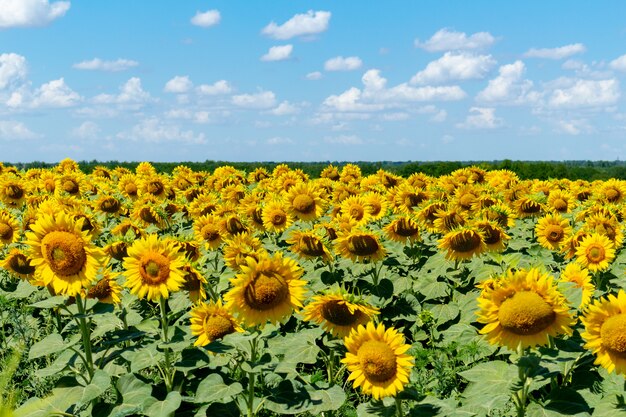Sunflowers are a versatile crop that has become increasingly popular among South African farmers due to their resilience, economic value, and multiple uses. Sunflower seeds are used to produce oil, animal feed, and even biofuels. As they are drought-tolerant, sunflowers are well-suited for South Africa’s diverse climate and are grown in regions such as the Free State, North West, and Mpumalanga. This guide will take you through the process of growing sunflowers from seed to harvest and storage, offering detailed information on each growth stage, necessary inputs, machinery, and pest and disease management.
1. Land Preparation
Proper land preparation is crucial for ensuring high sunflower yields. The process should start well before planting and involves:
- Soil Type: Sunflowers thrive in well-drained, loamy soils with good fertility. They can tolerate a wide range of soil types but perform best in slightly acidic to neutral pH levels (pH 6.0–7.5).
- Tillage: Conventional tillage or minimum-tillage practices can be used, depending on your equipment and farm size. Deep ploughing (30 cm) loosens the soil for good root penetration and aeration. After ploughing, harrowing should be done to break up large soil clods and create a smooth seedbed.
- Soil Testing: Before planting, conduct a soil test to determine nutrient levels and pH. This will help you apply the appropriate amount of fertilizers.
2. Seed Selection and Planting
Choosing the right seed variety is critical for the success of your sunflower crop. In South Africa, both open-pollinated and hybrid sunflower seeds are available.
- Seed Varieties:
- Hybrid varieties are recommended for higher yields and disease resistance. Popular hybrids include PAN 7080, PAN 7033, and Syngenta NK Adagio.
- Open-pollinated varieties are more affordable but may not offer the same yields or resistance to diseases.
- Planting Time: The best time to plant sunflowers in South Africa is from November to January, depending on the region. Sunflowers need warm soil to germinate, so the ideal soil temperature for planting is around 10–12°C.
- Seed Rate and Spacing:
- Use about 3–5 kg of seeds per hectare, with a row spacing of 70 cm.
- The planting depth should be between 3 to 5 cm, depending on soil moisture levels.
3. Fertilizer Application
Sunflowers respond well to proper fertilization, which ensures optimal growth and yield. Based on the results of your soil test, you will need to apply fertilizers at the following stages:
- Pre-plant Fertilization: Apply phosphorus (P) and potassium (K) during land preparation, as these nutrients help establish a strong root system. A typical pre-plant fertilizer mix might include 300–400 kg/ha of a compound fertilizer like 2:3:4 (30).
- Nitrogen Application: Nitrogen is essential for leaf and stem growth. Split the nitrogen application, with 50% applied at planting and the remaining 50% when the plants are around 30 cm tall. The recommended rate is 80–120 kg/ha of nitrogen, depending on soil fertility.
- Micronutrients: Sunflowers benefit from additional micronutrients like boron and zinc. Foliar sprays containing these micronutrients can be applied during the vegetative growth stage.
4. Irrigation and Water Requirements
Sunflowers are drought-tolerant but need adequate moisture during specific growth stages, particularly during seed germination and flowering. South African farmers typically rely on both dryland and irrigated sunflower production.
- Water Requirements: Sunflowers require about 500–600 mm of water throughout the growing season.
- Critical Stages for Irrigation:
- Germination: Ensure the soil is moist at planting time to promote seed germination.
- Flowering and Grain Filling: Sunflowers are most sensitive to water stress during the flowering stage (60–80 days after planting) and the grain filling stage. Adequate water at this stage ensures proper seed development and oil content.
- Irrigation Frequency: For dryland crops, sunflowers rely on rainfall, but supplementary irrigation may be necessary during dry spells. For irrigated crops, apply water every 7–10 days during the critical growth stages.
5. Growth Stages of Sunflowers
Understanding the growth stages of sunflowers is essential for proper management:
- Emergence (0–14 days): Seeds germinate and the first true leaves appear. Ensure the soil remains moist during this period.
- Vegetative Stage (15–45 days): The sunflower plants develop stems and leaves. Nitrogen fertilization should be applied at the early vegetative stage.
- Bud Formation (45–60 days): Flower buds start to form, and the plants begin to reach their full height. Irrigation and pest control are critical during this period.
- Flowering (60–80 days): Sunflowers bloom, and pollination occurs. Water stress during flowering can lead to reduced yields and poor seed development.
- Maturity (100–120 days): The plants start drying out, and the seeds mature. When the back of the sunflower heads turn yellow, the crop is ready for harvest.
6. Pest and Disease Management
Sunflowers are susceptible to several pests and diseases, particularly in South Africa’s warm climate. Early detection and appropriate control measures are key to preventing losses.
Common Pests:
- Cutworms: These pests attack young plants by cutting them at the base. Use pesticides or bait traps early in the growing season.
- Aphids: Aphids feed on the sap of sunflower plants and can transmit diseases like sunflower mosaic virus. Apply insecticides such as Imidacloprid when aphids are detected.
- Sunflower Head Moth: This pest lays eggs on the sunflower head, and the larvae feed on developing seeds. Use pheromone traps for monitoring and apply insecticides during the flowering stage if necessary.
Common Diseases:
- Rust: Caused by the fungus Puccinia helianthi, rust appears as reddish-brown pustules on the leaves. Fungicides containing Triazoles can be applied as a preventative measure.
- Downy Mildew: This disease causes yellowing of leaves and stunted growth. Use disease-resistant seed varieties and apply fungicides like Metalaxyl when needed.
- Alternaria Leaf Spot: This fungal disease causes dark spots on leaves and can lead to defoliation. Apply fungicides during the early growth stages if necessary.
7. Herbicide Use and Weed Management
Weeds can significantly reduce sunflower yields by competing for nutrients and water. Effective weed control is critical, especially during the early growth stages.
- Pre-emergence Herbicides: Apply pre-emergence herbicides like Acetochlor or Pendimethalin right after planting to control broadleaf weeds.
- Post-emergence Herbicides: Once the sunflower plants are established, apply post-emergence herbicides such as Imazethapyr to manage weed growth. However, ensure that these herbicides are safe for sunflowers to avoid crop damage.
8. Harvesting Sunflowers
Sunflowers are typically ready for harvest 100–120 days after planting. Timing the harvest correctly is important to avoid seed losses.
- Harvesting Equipment: For large-scale farms, use a combine harvester fitted with a sunflower header to cut and thresh the heads. For smaller farms, sunflowers can be manually harvested by cutting the heads and allowing them to dry before threshing.
- Moisture Content: Sunflower seeds should be harvested when the moisture content is 10–12%. If harvested too early, seeds may be immature, while harvesting late increases the risk of shattering and losses.
9. Storage of Sunflower Seeds
Proper storage ensures that sunflower seeds maintain their quality for oil production or other uses.
- Drying: After harvest, sunflower seeds should be dried to a moisture content of 8–10% to prevent mold growth and spoilage.
- Storage Conditions: Store seeds in well-ventilated, dry storage facilities to avoid excess moisture. Use aeration systems or fans to maintain consistent airflow. Ensure that the storage area is rodent- and pest-proof.
Sunflower farming in South Africa offers great potential, thanks to the crop’s adaptability and economic value. By following best practices for land preparation, seed selection, fertilization, and pest management, farmers can achieve high yields and quality products. Understanding the key growth stages, ensuring proper irrigation, and adopting timely pest and disease controls are crucial for maximizing profits. With careful planning from planting to storage, sunflower farming can be a highly rewarding venture in South Africa.
Join 'Farmers Mag' WhatsApp Channel
Get the latest Farming news and tips delivered straight to your WhatsApp
CLICK HERE TO JOIN






